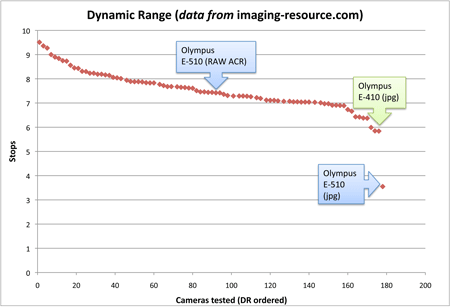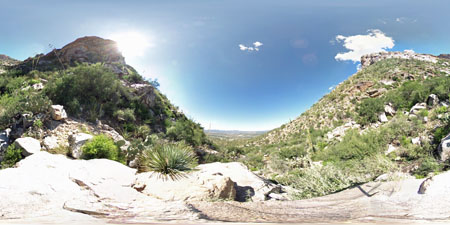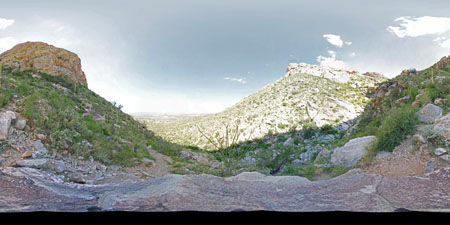It's hard to capture the scale and immersion of the canyons and peaks with conventional 2D camera technology. One day I plan to get a digital SLR and panohead and make 3D QT VR pictures.I've since tried a few, small spherical panoramas projects, e.g. MIT's Stata Center and LA's Getty Museum. I've also tested my setup on the east coast in Virginia's Cumberland Gap but I haven't had the opportunity to follow through on Pusch Peak until recently. So this autumn, I ascended the lower reaches of Pusch Peak with my spherical panorama gear. Unfortunately, the results are somewhat disappointing, revealing significant limitations of my equipment and process. At altitudes of 1000m to 2000m, the strong desert sun here makes for unrelentingly harsh lighting (except during early mornings and dusk). In other words, rather challenging conditions for cameras, especially if one needs to capture a 360° view within a canyon at mid-afternoon, which will inevitably contain both brightly lit surfaces and deep shadows. I'm using an Olympus E-510. And I've been taking jpeg images. As it turns out, the dynamic range of this combination has been tested to be well below par, see below:

This hasn't mattered until now. It appears the solution, apart from getting a better camera, is to use RAW (not jpeg) images and maybe Adobe Camera Raw (ACR) to develop them. Assuming the test results translate well to the real world, I should be able to get nearly 3 stops more dynamic range without having to resort to bracketed exposures (for HDR etc.). [Update: from discussion on dpreview.com, Jay Turberville pointed out that there must be something wrong with Imaging Resource's result for the E-510. The Olympus E-410, basically identical, tested out with a dynamic range of 5.99 on JPG. Still below par though.] I will have to issue a promissory note here: to make time to ascend Pusch Peak again with my camera gear. And see if RAW will make a significant difference in real-world testing. (I'd also love to test a camera with state-of-the-art dynamic range but I don't know anyone with a Nikon and fisheye.) Meanwhile, to illustrate the problem, here are the two least blown-out spherical panoramas from my first shoot. The first panorama is from lower down on the hike. Since the sun is mostly hidden, this one came out the best:

pano1.mov (10.2MB file, use QuickTime player)
pano1.swf (Adobe Flash) The second panorama was taken higher up. As you can see, I've diddled around with exposure curves a bit in an attempt to recover as much detail as possible but you can clearly see nasty artifacts such as banding in the sky.

pano3.mov (9.6MB)
pano3.swf (Adobe Flash)

No comments:
Post a Comment